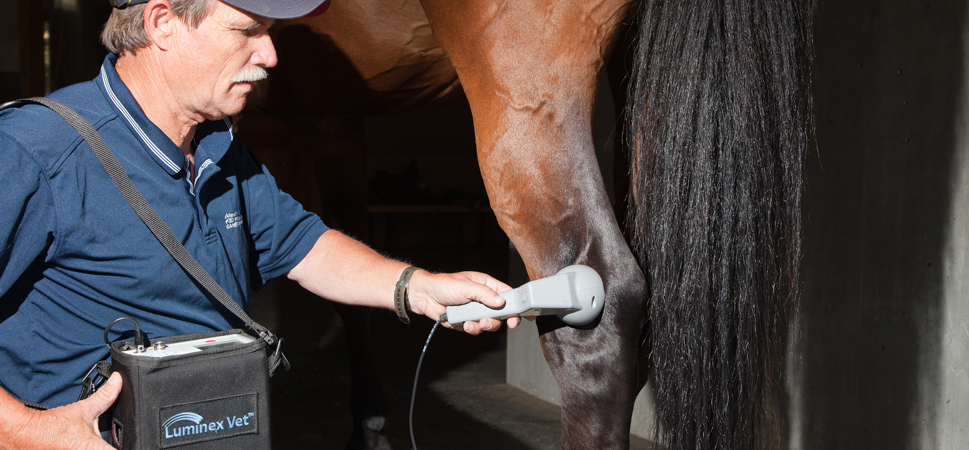Equine Therapy for Kid: Psychological and Behavior Assistance Clarified
Equine Therapy for Kid: Psychological and Behavior Assistance Clarified
Blog Article
Discovering the Advantages of Laser Treatment in Equine Treatment for Boosted Recovery
The development of laser treatment in equine treatment provides an encouraging avenue for enhancing healing and overall health. Especially reliable for soft cells injuries, laser therapy likewise plays a substantial function in taking care of chronic pain and boosting blood circulation. Its capability to boost collagen manufacturing further adds to cells honesty.
Exactly How Laser Treatment Functions
Laser treatment, an advanced method in equine therapy, runs by giving off specific wavelengths of light to permeate tissues and boost mobile processes. This advanced modern technology harnesses the power of photons to engage with chromophores within the cells, activating photochemical reactions that boost cellular metabolic process. The key device involves the absorption of light by mitochondrial chromophores, leading to boosted production of adenosine triphosphate (ATP), the cell's power currency.
The elevation in ATP levels increases various biological procedures, including improved protein synthesis and cell proliferation. Additionally, laser therapy regulates inflammatory responses by decreasing pro-inflammatory cytokines and boosting anti-inflammatory cytokines. This dual action aids in reducing discomfort and promoting tissue repair work.

Benefits for Soft Cells Injuries
When addressing soft cells injuries in horses, laser therapy supplies a wide range of benefits that dramatically boost healing end results. Soft cells injuries, encompassing tendons, ligaments, and muscular tissues, are usual in equine professional athletes and frequently call for extensive recovery durations. Laser treatment, or photobiomodulation, advertises mobile regeneration and enhances tissue repair by boosting mitochondrial task, consequently speeding up the natural recovery procedure.
One of the primary benefits of laser therapy is its capacity to lower swelling. By targeting the damaged area with particular wavelengths, laser treatment reduces the inflammatory reaction, lowering swelling and connected pain. This anti-inflammatory effect is important in taking care of the first stages of injury, where extreme inflammation can impede healing.

In addition, laser therapy boosts the production of collagen, an important healthy protein for maintaining the integrity and flexibility of soft cells. Enhanced collagen synthesis accelerates the repair of broken frameworks, decreasing the danger of reinjury. Laser therapy offers a non-invasive, drug-free remedy for accelerating the rehab of soft cells injuries in equines.
Handling Persistent Pain
In the realm of equine medical care, taking care of chronic discomfort presents a considerable difficulty, usually requiring multifaceted approaches for efficient therapy. Persistent discomfort in equines can originate from a range of resources, including arthritis, laminitis, check over here and various other degenerative problems. Typical management methods, such as anti-inflammatory medications and physical treatment, have their values yet can be limited by adverse effects and irregular efficacy.
Laser therapy has actually arised as an appealing adjunctive therapy for managing chronic pain in horses. This non-invasive method uses particular wavelengths of light to permeate tissues, promoting mobile repair and reducing swelling. By boosting microcirculation and stimulating the launch of endorphins, laser therapy can provide considerable discomfort alleviation without the damaging results typically connected with pharmaceuticals.
The capability to target particular pain sites precisely makes laser treatment a flexible device in the detailed pain administration arsenal. As research proceeds to progress, the assimilation of laser therapy in equine persistent discomfort monitoring holds substantial possibility for enhancing the quality of life for influenced equines.
Enhancing Recuperation Times
Structure on the promising end results observed suffering management, laser therapy likewise shows considerable capacity in boosting recuperation times for equine individuals. This technique functions by increasing cellular regrowth and boosting blood circulation, which are important consider the recovery process. The application of laser therapy boosts the manufacturing of adenosine triphosphate (ATP), consequently raising the energy available for cellular fixing and reducing inflammation.
Professional researches have shown that equines treated with laser therapy exhibit quicker recovery from bone and joint injuries, operations, and soft tissue damages. The decrease in inflammation and discomfort not only help in faster tissue repair service but additionally enables earlier and a lot more reliable rehabilitation exercises. This is especially beneficial for performance horses, where decreasing downtime is vital for keeping affordable schedules.
Moreover, laser therapy can be specifically targeted to particular injury sites, ensuring that the restorative impacts are local and powerful. This precision reduces the likelihood of adverse effects and promotes extra regular healing results. Equine veterinarians are significantly incorporating laser treatment into their therapy procedures, recognizing its efficiency in speeding up recuperation times and enhancing the total healing process for equine people.
Improving Overall Well-being
As laser treatment remains to obtain traction in equine medication, its benefits prolong past just injury recovery, substantially adding to the general health of equines (Equine Therapy). This therapeutic technique has demonstrated efficacy in alleviating chronic discomfort, minimizing swelling, and advertising cellular regrowth. Such results are not just critical for recovery yet top article additionally enhance the top quality of life for equine patients, guaranteeing they stay energetic and web content
Among the key elements in which laser therapy aids in improving total wellness is via its analgesic results. Pain administration is vital for steeds, particularly those associated with affordable sports or strenuous tasks. By minimizing discomfort, laser therapy enables these animals to perform ideally and lowers the danger of offsetting injuries.

Conclusion
In recap, laser treatment presents a significant innovation in equine hop over to these guys treatment by stimulating mobile regrowth, minimizing swelling, and speeding up healing procedures. This non-invasive technique relieves discomfort, enhances blood flow, and advertises efficient nutrient distribution to injured cells. Furthermore, the therapy's ability to boost collagen production ensures the maintenance of tissue stability. Laser therapy arises as an indispensable device for optimizing recovery and improving the overall wellness of horses.
Report this page